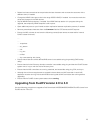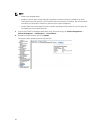
Feature Version 2.0 Version 3.0
CIFS home shares Clients can access CIFS
home shares in two ways:
\\<client_VIP_or_name>
\<path_prefix>\<username>
\\<client_VIP_or_name>
\homes
Both access methods point
to the same folder.
Version 3.0 does not include the “homes”
access method. After the upgrade, the “homes”
share will not be present, and clients will need
to use the “username” access method instead.
If you have a policy that mounts the \
\<client_VIP_or_name>\homes share when
client systems start, you must change the
policy to mount the \\<client_VIP_or_name>
\<path_prefix>\<username> share.
Local user names A period can be used as the
last
character of a local user
name.
A period cannot be used as the last character
of a local user name.
Before upgrading, delete local user names that
have a period as the last character and re‐
create the accounts with a different name.
Local users and local
groups UID/GID range
A unique UID (user ID) or GID
(group ID) can be configured
for
local users and local groups.
The UID/GID range for local users and local
groups is 1001 to 100,000. There is no way to
configure or determine the UID/GID of local
users and local groups. This information is
internal to the FluidFS cluster.
During the upgrade, any existing local users
and local
groups from version 2.0 with a UID/GID that is
outside the version 3.0 UID/GID range will
remain unchanged. Local users and local
groups created after the upgrade will use the
version 3.0 UID/GID range.
Guest account
mapping policy
By default, unmapped users
are
mapped to the guest
account, which allows a
guest account to access a file
if the CIFS share allows guest
access.
Unmapped users cannot access any CIFS
share, regardless of whether the CIFS share
allows guest access.
Guest access is enabled automatically after the
upgrade only if there are guest users already
defined for any CIFS shares in version 2.0.
NDMP client port The NDMP client port must
be in
the range 1–65536.
The NDMP client port must be in the range
10000–10100.
Before upgrading, the NDMP client port must
be changed to be in the range 10000–10100.
You must also make the reciprocal change on
the DMA servers.
Replication ports TCP ports 10560–10568 and
26 are used for replication.
TCP ports 10550–10551 and 10560–10568 are
used for replication.
Snapshot schedules Snapshot schedules can be
disabled.
Snapshot schedules cannot be disabled.
During the upgrade, disabled snapshot
schedules from version 2.0 are deleted.
Internal subnet The internal (interconnect)
subnet
can be changed from a Class
C
subnet during or after
deployment.
The internal subnet must be a Class C subnet.
Before upgrading, the internal subnet must be
changed to a Class C subnet, otherwise the
service pack installation will fail with the
following message:
“Please allocate a new C-class subnet for
FluidFS Internal Network, run the following
23


















